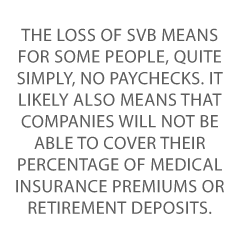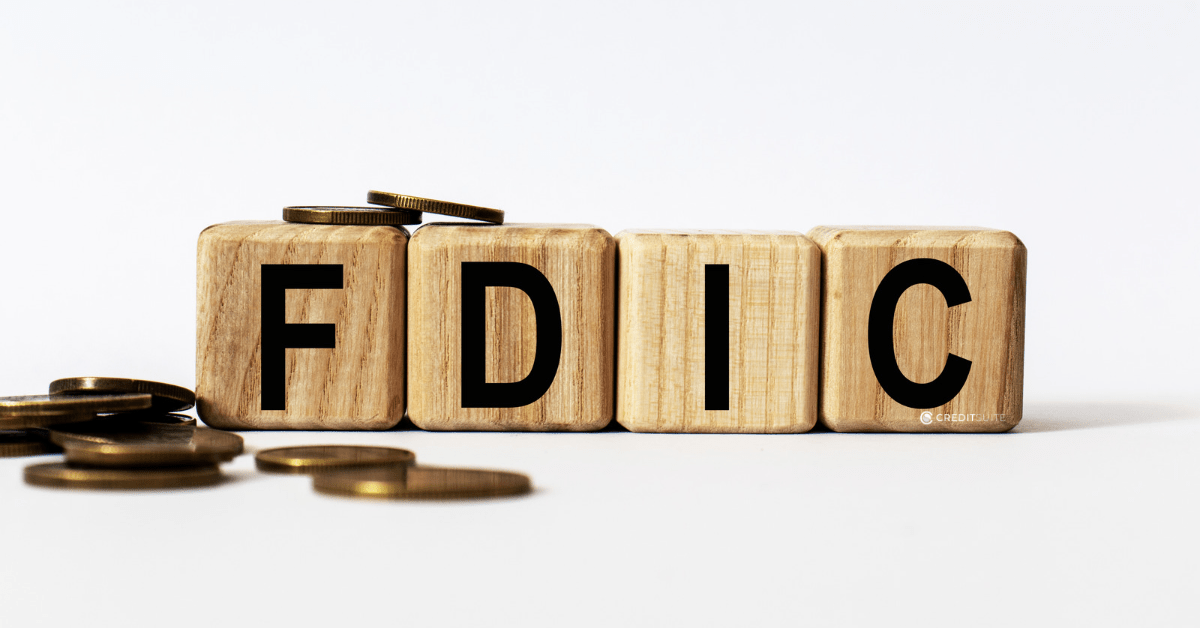It’s bad news for depositors in Silicon Valley Bank. Last week, the FDIC reported it had taken over SVB, as this Santa Clara financial institution reported it had lost some $1.8 B in investments after conducting a fire sale of its bond portfolio.
NOTE: THIS IS A BREAKING STORY AND WILL UNDOUBTEDLY KEEP CHANGING
The California Department of Financial Protection and Innovation (DFPI) in San Francisco announced on March 10th that, pursuant to California Financial Code section 592, it was taking over Silicon Valley Bank. The reason, it said, was “inadequate liquidity and insolvency.”
Also, the FDIC created the Deposit Insurance National Bank of Santa Clara to protect insured depositors of Silicon Valley Bank.
According to the Associated Press, SVB Financial Group was the country’s sixteenth largest bank. This is the largest bank failure in years. Even Treasury Secretary Janet Yellen is concerned.
And, of course, even Wall Street, all the way in New York, is reacting. Signature Bank stocks, for example, had their worst day ever. More on Signature further in this post.
A Billion Here, a Billion There—What’s a Billion Dollars Among Friends?
A lot, that’s what.
But let’s back up and start from the beginning, shall we?
![]() Silicon Valley Bank became a darling of startups, including venture-backed businesses. The Federal Deposit Insurance Corp. (FDIC) insured the bank. It seemed stable. All seemed well.
Silicon Valley Bank became a darling of startups, including venture-backed businesses. The Federal Deposit Insurance Corp. (FDIC) insured the bank. It seemed stable. All seemed well.
Not so fast.
Inflation hacked away at SVB’s holdings, and they realized they could not cover demands for money. They started selling off holdings and reporting this issue. Then there was a run on the bank, and the FDIC stepped in.
The FDIC and SVB
According to their website,
“The Federal Deposit Insurance Corporation (FDIC) is an independent agency created by the Congress to maintain stability and public confidence in the nation’s financial system. The FDIC insures deposits; examines and supervises financial institutions for safety, soundness, and consumer protection; makes large and complex financial institutions resolvable; and manages receiverships.”
But keep one thing in mind: the FDIC’s insurance limit is financial protection for deposits of up to $250,000. If your account has, say, $600,000 in it, then the FDIC will only help you out to the tune of that first $250,000.
For the other $350,000, insured depositors would have been out of luck, unless they wanted to wait for their turn during bankruptcy proceedings. Fortunately, the Biden Administration has stepped in and says they will cover the remainder.
As of the last quarter of 2022, about 97.3% of all deposits at Silicon Valley Bank were in excess of $250,000. So, out of 100 depositors, over 97 of them would have suffered asset losses due to the failure of this bank. With such a small percentage of insured deposits, many investors wouldn’t have been much better off than uninsured depositors.
How much will this bailout cost the American public? As of the end of 2022, SVB had over $209 billion in assets under management. Expect the price tag, beyond the payouts via the FDIC, to top $100 B at the very least.
It gets better…
Let Us Return to a Simpler Time, in 2020
According to BankRate, the last time an FDIC-insured bank failed was in October of 2020, when Alamena State Bank went bust.
Before that, it was 2004. Silicon Valley Bank’s failure ends the second-longest streak of no failures (the longest run was from 2004 to 2020).
The Washington Mutual S&L failed in 2008, as a part of the Great Recession. WaMu is still the largest-ever failure, at over $300 B.
And let’s go back even further, to 1933. One of the causes of the Great Depression, and one of the reasons it was extended in the United States, was due to bank failures and runs on banks. But the Banking Act of 1933 helped to change all that.
By insuring a substantial amount of money (substantial for a lot of people, that is), the FDIC helped to stabilize the banking industry. Knowing that their money was all or nearly all protected was enough to restore people’s faith in the system.
Banking regulators would be on the case, making sure that the total assets of a bank would stay secure. Investors and portfolio companies would be able to breathe more easily.
Back to Now
Life is a bit different now. For one thing, we are in the midst of serious inflation. And, we are in the midst of the Federal Reserve working to raise interest rates in an effort to slow down inflation.
Put the two together, and it was trouble for the Silicon Valley Bank.
According to Entrepreneur,
SVB found itself in a difficult position after rising interest rates, which make it more expensive to borrow money, taking a toll on the world of venture-backed startups.
After the bank made the announcement about the losses late Wednesday (March 8th), people in the startup world, like Activant Capital, advised people to get out of the bank. SVB’s bank stocks dropped some 60% on Thursday the 9th.
If you recall the movie, It’s a Wonderful Life, there is a scene of a run on the bank. And that is pretty much what happened, albeit with monetary amounts that were several orders of magnitude higher than those in the classic film.
Startups, Venture Capitalists, and the FDIC Limit
For a lot of startups, and for a lot more venture capitalists, $250,000 is pocket change. But at least it’s better than things were in 2005, when the limit was $100,000.
Investors and depositors became particularly skittish on Thursday, March 9th, when the bank announced that it was planning to raise up to $1.75 billion in order to strengthen its capital position. Silicon Valley Bank executives did what they could.
Shares nosedived by 60%, and even more on Friday, March 10th, when NASDAQ (where SVB Financial Group is traded) opened up.
SVB Financial Group liquidated $21 B in assets to cover their shortfalls, and ended up losing $1.8 B on that sale alone.
By Friday noon, the major depositors at Silicon Valley Bank had acted so quickly that there was just about nothing left. The Santa Clara bank run was so fast and the deposit outflows were so thorough that the FDIC was unable to find a buyer for the bank’s assets, such as they were.
All remaining uninsured deposits were locked up and wouldn’t be available until receivership, so the Federal government stepped in. As for the insured percentage of deposits, the FDIC worked to make them available on Monday, March 13th. The FDIC and the remainder of the Federal government is looking to make 100% of all deposits available but experience warns that it’s likely that will not be immediate.
What’s the Word Directly from SVB?
Very little. In fact, as of Friday, March 10th, their most recent press releases were glowing reports about SVB being named one of America’s Best Banks by Forbes on February 14th, of 2023.
My, how the tables have turned over in Santa Clara.
What Does This Mean for Rank and File Workers?
 The loss of SVB means for some people, quite simply, no paychecks. It likely also means that companies will not be able to cover their percentage of medical insurance premiums or retirement deposits.
The loss of SVB means for some people, quite simply, no paychecks. It likely also means that companies will not be able to cover their percentage of medical insurance premiums or retirement deposits.
Are startups worried about this? Absolutely. Just like other employers, they need to attract and retain top talent. That has been harder to do these days, in the wake of the quiet quitting movement and other changes in our society.
Being unable to cover paychecks and benefits is only going to make employee hiring and retention more difficult for startup businesses.
Will the failure of Silicon Valley Bank lead to a ripple effect and cascading failures in the startup scene? It is not outside the realm of possibility, although right now the crystal ball is a little cloudy.
But it is less likely to result in cascading failures among venture capitalists and VC firms. VCs have a lot of money to start with. VC firms that are well-managed do not put all their financial ‘eggs’ into one basket.
A typical venture capitalist is a far more savvy depositor. The same is true of a typical venture capital firm. They may even want to put money into crypto or the like (although crypto is likely to become regulated soon).
Signature Bank
On Sunday, March 12, state regulators closed Signature Bank of New York. Per the Washington Post, the Federal government’s financial protection will extend to Signature’s customers as well. In addition according to WaPo,
Fed officials declined to provide a specific figure for the size of that new loan program, but made clear it would be large enough to cover trillions of dollars in potential requests.
Signature Bank had over $110 B in assets under management. It was mainly a favorite of wealthy depositors. It was also the third-largest bank failure in history; Silicon Valley Bank is #2 and Washington Mutual in 2008 is #1.
In contrast, back in 2008, Washington Mutual had $307 B in assets under management. But when you combine Silicon Valley Bank and Signature Bank, it’s more than that, to the tune of about $320 billion.
Politics, Politics
A move that costs trillions of dollars and mainly protects wealthy VCs and California dude bros is not likely to be popular with some politicians. Expect at least some protestations. But at the same time, the economy will likely go into a tailspin if this contagion of fear spreads to depositors in a third or a fourth bank, or more.
According to CNN Business,
The Fed will also make additional funding available for eligible financial institutions to prevent runs on similar banks in the future.
This already expensive bailout is likely to become even more expensive.
The President went on TV on Monday, March 13 in an attempt to assure the public and to vow that there would be accountability.
Also, according to Politico,
The Treasury Department, Federal Reserve and FDIC vowed that taxpayers would not bear losses from the moves to bolster the depositors at the two shuttered lenders, Silicon Valley Bank and Signature Bank.
This is a lovely idea in theory, but the reality is that taxpayers will have to pay something, whether directly or indirectly. It isn’t practical for the government to just print more money to cover these issues (and that could lead to hyperinflation anyway).
And then there’s the question of who knew what, and when.
Insider Dealings?
It’s been reported that Peter Thiels Founders Fund pulled its funds from SVB before the collapse. Was that a savvy move, or a product of insider knowledge?
And according to the New York Post, the CEO of SVB pulled about $3.5 M in stocks before the collapse. That’s going to take a lot more explaining. The Senate Banking Committee and the House Financial Services Committee might have a few questions for SVB’s CEO, Greg Becker.
This thing ain’t over yet, folks.
How Does This Affect You?
Of course, if you have or had deposits in Silicon Valley Bank or Signature Bank, then you are directly affected. But what if you’re just a bystander?
If your business is in the tech sector, or your customers and prospects are, then there is every chance that the failures of Signature and SVB will affect you, at least indirectly.
Investors may be a little less likely to do business with you or your customers and prospects. And your prospects and customers may want to hold onto their money for a bit longer.
Of course they will have to buy necessities, just like any other business. But they will be hunting for bargains, and might not be interested in forking over cash for anything that does not feel as if it is immediately needed.
A wise business owner might consider briefly cutting prices in order to attract bargain hunters—or at least offering better net terms.
One Degree or More of Separation Back
For businesses that are not in the tech sector and/or do not really have customers in it, there will still be effects. A purely medical business, for example, may find it tougher to get new equipment at good prices. Remember how it was hard to buy new cars due to a lack of computer chips? Something similar could happen here, too.
Those same businesses that would be hunting for bargains for themselves might not be willing to provide any for their own customers.
If the failures trickle down and startups begin to go out of business, it will be harder to get some materials from tech companies.
Even further removed businesses could still be affected. If you own a long haul trucking company, you may find it harder to replace or upgrade computers or vehicles if startups are no longer making or perfecting the computer chips necessary to run them.
The Future of Financing
Bank collapses tend to generate both regulation from the government and a wait-and-see attitude from other banks. Where will it be easiest to get financing? Probably from alternative lenders, although look to them to catch the eye of politicians in the future, especially seeing as alternative lenders are investing in the same kinds of financial instruments that precipitated the 2008 crisis.
But this time, instead of being subprime mortgages, it’s investing in businesses and people who have more risk factors than a typical bank is willing (or able to do, under regulations) to take a chance on. So expect the introduction of more regulation here, too.
For the best in financing, and to assure the best chances of approval, the answer is still — Business Credit! As banks will raise their requirements, and alternative lenders either do the same or potentially merge, business credit is what will still be a port in the storm for small business owners.
And building a Fundability Foundation™ will always be a good idea for small businesses looking to get financing now and in the years to come.
Takeaways
When one bank fails, other banks will pick up the slack. Other lenders will step in and do business with many of these same startups. There will be some startup businesses which experience a brief hiccup and nothing more. But there may also be some startups which crash and burn as much as these banks have.
It’s also highly unlikely that the failures of Silicon Valley Bank and Signature Bank will turn venture capitalists off from investing in startups. If VCs feel a startup has potential, then they will merely move their money elsewhere. There will still be venture capital backed companies.
And no matter what, it will be a word to the wise for any business—to not put all your financial eggs into just one basket.
This story has been reported by the Wall Street Journal and Yahoo Finance, among many others. We will continue to follow it, too.
If you’re looking for help with your business credit—a form of financing utterly unaffected by the SVB debacle—then you’ve come to the right place.
Credit Suite can help you establish and build your small business credit. Make yourself another ‘basket’ for your business’s finances.
Contact us today to get started.



